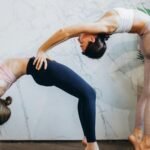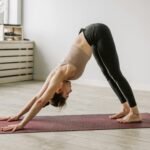This complete guide explores gentle yoga, a softer form of traditional yoga that focuses on slower, thoughtful poses and deep breaths. It is aimed at promoting mindfulness and relaxation, helping practitioners develop a better listening touch and improve their relationship with their breath, body, and mind.
Gentle yoga is a more calming practice that can be beneficial for individuals of all fitness levels, despite challenges such as injuries and chronic diseases. The principles, pose selection, and approaches of gentle yoga will be thoroughly understood to support the journey towards a transformative yoga journey. Gentle yoga offers tools for relaxation, flexibility, and a sense of peace in the modern world.

What is Gentle Yoga?
Gentle yoga is a quiet, soft form of yoga practice suitable for beginners, seniors, and children. It emphasizes relaxation, listening to the inner self, and stretching. It prepares the body and soul through gentle movements, proper breathing, and meditation. Asanas in yoga are tailored to individual limits, making gentle yoga the most universal type for beginners, seniors, and those with wounded body parts and intensive jobs. The main focus of gentle yoga is alignment, connected breathing, and finding the center of peace. By incorporating subtle stretching and strengthening exercises, practitioners increase flexibility, balance, and posture while relieving muscle tension and creating a pleasurable feeling of wellness.
Practising gentle yoga helps the nervous system quiet down, settling the mind, and providing relaxation methods like deep breathing, guided imagery, and meditation. It is versatile, allowing individuals to design their workout routines based on their tastes and styles, providing a gentle yet effective nourishing tool for fulfilling both body and soul needs.
Gentle Yoga Poses
Gentle yoga is a tranquil practice that combines peaceful poses and gentle asanas to deepen consciousness and achieve perfect balance. This practice is ideal for beginners, aiming to deepen consciousness, achieve mindfulness, and rest peacefully. It offers a calm environment to tune in to the body and breath, nurturing from within. Quintessential gentle yoga poses form the foundation of this practice, providing a serene way to begin a health-centric journey.
Child's Pose (Balasana)
Begin with the position of kneeling on the mat and then lower your body gently all the way down so that your forehead touches the surface of the floor. Take your arms to your side or over your head, as if you were breathing into your back, hips, and shoulders. The stretching will extend the deepening of your breath. This pose, which stretches tenderly to impede the build-up of anxiety, gives in to relax.

Cat-Cow Stretch (Marjaryasana-Bitilasana)
Make a transition to a stable tabletop side: even out your wrist and keep your knees under your hips. Inhale while arching your back and your tailbone alongside your chest upward (Bowing to the Ceiling). Inhale as you arch your upper body, lifting your chin towards the outstretched fingers (Cow Pose). Then exhale as you round your spine and bring your chin back to your chest (Cat Pose). As the moves pass by with the breath, this flow of rhythm makes the flexibility of the spine better and soothing according to the level of the difficulty of doing this acts.

Forward Fold (Uttanasana)
With the feet hip-width apart and flat on the ground, start by doing a forward-hinge bending at hips while keeping your arms and body relaxed and allow your body to hang over the legs in a relaxed manner. As if you were small bow, put your knee down and place your head so you are like a heavy weight. This slow-running technique triggers relaxation and helps in taking the strain of hamstrings and also the back muscles.

Seated Twist (Ardha Matsyendrasana)
Roll out the mat and sit in it comfortably keeping hands on your knees, if that is easy then bend your right knee and place that foot on the outside of the thigh of your left leg. Inhale to make stretch up the spine and during the exhale to twist gently to the right where the left hand would be on the outside of the right knee and the right one behind you. It assists with food digestion, massage the abdominal organs, and adds more energy and strength to the spine.

These simple gentle poses present newcomers to the world of mindful movement a place where they are safe to discover the wonderful effects of slow movement and breathing. The movement becomes a sanctuary that calms even the most chaotic mind. Implements this in your daily life to foster a stronger religiosity and peacefulness.
How to Practice Gentle Yoga Safely
Gentle yoga is a safe and effective form of exercise, but there are some precautions to take to ensure the fullest benefit.
Start Slowly
As water is the best friend of the aquatic solution, in the same manner, practicing gentle yoga is all about your body and your own pace. Start with easy poses that will prepare you for more advanced ones and include Child’s Pose, Cat-Cow, and Forward Bending poses. Such postures will not leave you tangled whereas they help in gently stretching the body.

Focus on Breath
observe your breathing not only at the beginning but also regularly during the practice. Hearty and deep in take a highly reliable in relaxing body but, increase flexibility and reduce stress as well. Include breath manipulations as your movement becomes universal, so the two become inseparable.

Modify Poses
Not to procrastinate to move from one posture to another which is suitable fulfill your needs and physical limits. Add accessories such as floor-length pieces, heavy ties, and table top equipment so as to reduce the load on your muscles that otherwise become disproportionately over-strained. So beware, it is not about having the best asana; rather, it’s all about finding what is specifically on your mind.

Seek Guidance
Why not try to join a class of restorative yoga led by a yoga teacher who is certified, at least if you are a total newbie to yoga? An accomplished teacher will be able to rule out in the classroom, aid in the execution of poses, and provide specific modifications for your particular situation when needed.


Read about “IS YOGA A SIN: DEBUNKING MYTHS AND EXPLORING TRUTHS” CLICK
Benefits of Gentle Yoga
In the realm of holistic wellness, understanding “what is gentle yoga” is pivotal for beginners embarking on their journey towards physical and mental rejuvenation. Gentle yoga, characterized by its soothing and mindful approach, offers a myriad of benefits that harmonize the body and mind.
Physical Benefits
Gentle Yoga Benefits
• Builds flexibility and strength through gentle postures.
• Promotes improved posture and muscle tone.
• Provides controlled stretches and movements to relieve chronic pain.
• Enhances lung capacity and general oxygenation.
• Emphasizes respiratory system efficiency through specific breathing exercises.
Mental Benefits
Gentle Yoga Benefits
• physically and mentally heals, promoting calmness and peace.
• Breathing exercises and guided meditation provide stress relief and mental concentration.
• Mindful practice creates emotional assistants, facilitating inner peace.
• Potentially effective in sleep therapy, achieving ideal relaxation for sleep.
Gentle yoga provides a holistic wellness approach, addressing both physical and mental needs. It acts as a pillar of peace, providing options for inner peace and physical health recovery.
Conclusion
FAQ
Most frequent questions and answers
Gentle yoga emphasizes slow, mindful movements and deep breathing, making it suitable for all fitness levels. It focuses on relaxation, flexibility, and stress relief, promoting physical and mental well-being.
Gentle yoga, a form of yoga that emphasizes strength, flexibility, and mindfulness, differs from restorative yoga in its focus on deep relaxation and passive stretching.
Yes, practicing gentle yoga daily can be beneficial for most people, as it promotes flexibility, relaxation, and overall well-being. However, it’s important to listen to your body and modify or take breaks as needed to prevent overexertion or injury.
Gentle yoga improves flexibility, reduces stress, enhances relaxation, and promotes posture, balance, and overall well-being, making it suitable for beginners and those seeking a gentle fitness and mindfulness approach.








[…] Yoga is basically a limitlessness mentality which is based on the idea of exploration and freedom. The […]
[…] experts recommend to practice gentle yoga before doing advance […]
[…] hustle and bustle, we often overlook the simple need for a bit of tenderness and relaxation. Gentle yoga steps in as a serene escape, urging us to approach our practice with softness and […]